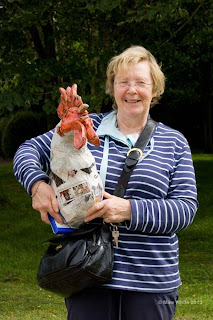Cate Blanchett, by Bill Henson for TIME magazine, 2013.
http://au.blouinartinfo.com/news/story/936757/bill-henson-on-his-portrait-of-cate-blanchett-for-timeThis image attracted me and I wondered why. Bill Henson's responses in the article above didn't answer my question, so I studied the image itself.
Composition
A portrait-format rectangle. The head and the hand are illuminated against a black background. The line of the truncated neck leads the gaze to the wrist's truncation. The bend of the hand draws it back towards the face, yet the curled fingers slow the gaze's amovement so that it lingers on the face before travelling around the outline back over the hair to the nape. The whole forms a kind of inverted teardrop, flying upwards from bottom left towards top right.
Mood
There's a pensive uncertainty to the pose. The model looks left and down, back towards the past, not right and forwards to the future. The fingers are raised to the mouth, a common action indicating uncertainty. Possibly the ancestor of this gesture is finger-or thumb-sucking as a source of comfort. The eyes are downcast, open but unseeing; the model sees in her mind's eye and does not desire the distraction of seeing something physical.
Pose and Lighting
The photograph is taken with a portrait lens, say 90mm. There is a single diffused light, high and slightly left. It illuminates the contours, modelling the nearer half of the face. The other half is nearly in darkness. The unlit cheek is just visible and its edge is in line with with the tip of the nose, avoiding over-emphasis of this feature. A standard three-quarter face then. The brightest point is the hand; it attracts the gaze and supports the weight of the head. The index finger could be straight; the top joint can't be seen; it may even be in the mouth. The other fingers curl progressively; the pinkie almost touches the palm. There are no catch-lights on the eyes: they would be inappropriate; the model is introspective, not alert.
Model
Cate is beautiful, blonde, smooth-skinned and very slim. The lighting, mainly on the nearer side of the face, accentuates what flesh covers the skull. To have lit the distant side of the face instead would have slimmed the nearer side even more. The hair is a little untidy. This imperfection is artful: hair as smooth as the complexion would have suggested a statue rather than a human being. Instead, it indicates humanity and reflects the uncertainty of the subject. Colour is used here to soften the image.
Harrison Ford, by Michael Birt, May 1999, New York
https://www.google.co.uk/search?q=michael+birt+photographer&tbm=isch&tbo=u&source=univ&sa=X&ei=y_ayUqL2Lcep0AW454GoAQ&ved=0CEoQsAQ&biw=1440&bih=788#facrc=_&imgdii=KscLWaG4vYk8rM%3A%3BYUjmROlkVWc6DM%3BKscLWaG4vYk8rM%3A&imgrc=KscLWaG4vYk8rM%3A%3BGOTr_RpWP1fXGM%3Bhttp%253A%252F%252Fwww.ephotozine.com%252Fimages%252Fexhibitions%252Fnorm%252F1032_1169035329.jpg%3Bhttp%253A%252F%252Fwww.ephotozine.com%252Fexhibition%252Fmichael-birt--portraits-1756%3B300%3B300A complete contrast; there's no uncertainty or introspection here.
Composition
Square format. Head and shoulder, closely cropped, losing the top of the head and part of the shoulder. The model presses against the right-hand edge of the frame, prevented from escaping by the raised forearm, leaving a blank area upper left. The hands are visible, pressed into the face. They seem strong. The shadow along the large vertical muscle at the side of the neck (M. sternocleidomastoideus) emphasises its strength. The model makes a truncated triangle, a strong, stable shape. There's tension in the hand supporting the chin. Everything in the pose and composition is about strength.
Pose and Lighting
A wide-angle lens allows the photographer to get close; the model is in the viewer's space. The model faces full front and stares at the camera. The nearest hand is foreshortened, but the ear is very much reduced. There are two lights; a diffused rectangular box provides most of the illumination, modelling the face, cheek and neck and spilling softly onto the plain background to contrast with the model's black T-shirt. The right-hand eye is shaded from by the bending fingers of the hand. Another light, small and direct, provides a catch-light in each eye, especially the shaded one. The direct, close gaze is challenging; this is someone to be reckoned with. The impact of monochrome makes this a hard image.
The photographer says, "Ford's obvious physical strength, intelligence and intensity were summoned for a private moment in the studio." To me, the actor looks fed up.
The World's Top Photographers' Portraits, 2004, Fergus Greer, Rotovision SA, Switzerland.


































































